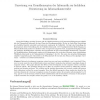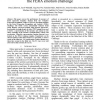1380 search results - page 267 / 276 » Learning Hierarchical Shape Models from Examples |
DIDACTICA
2000
13 years 7 months ago
2000
Abstract During its development computer science has more and more established a way it sees itself. However, in recent years the rise of distributed systems and object orientation...
IJCV
2000
13 years 7 months ago
2000
This paper presents a general, trainable system for object detection in unconstrained, cluttered scenes. The system derives much of its power from a representation that describes a...
CVPR
2008
IEEE
14 years 9 months ago
2008
IEEE
Recognizing people in images is one of the foremost challenges in computer vision. It is important to remember that consumer photography has a highly social aspect. The photograph...
CORR
2011
Springer
13 years 2 months ago
2011
Springer
Modeling the behavior of imperfect agents from a small number of observations is a difficult, but important task. In the singleagent decision-theoretic setting, inverse optimal co...
FGR
2011
IEEE
12 years 11 months ago
2011
IEEE
—This paper assesses the performance of measures of facial expression dynamics derived from the Computer Expression Recognition Toolbox (CERT) for classifying emotions in the Fac...


